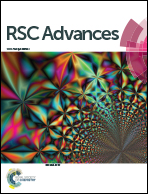Green synthesis of a Cu/reduced graphene oxide/Fe3O4 nanocomposite using Euphorbia wallichii leaf extract and its application as a recyclable and heterogeneous catalyst for the reduction of 4-nitrophenol and rhodamine B
Abstract
Herein, we describe a green and eco-friendly synthesis method for preparing a Cu/RGO/Fe3O4 nanocomposite through biological reduction of graphene oxide and Cu2+, Fe3+ ions using Euphorbia wallichii leaf extract as a reducing and stabilizing agent. UV-vis spectroscopy and FT-IR analysis were used for characterization of the extract and resulting nanoparticles. The synthesized nanocomposite was characterized by FESEM, EDS, TEM, FT-IR, XRD, BET, VSM and elemental mapping and was then used successfully as a magnetically separable and reusable catalyst for the reduction of 4-nitrophenol (4-NP) and Rhodamine B (RhB) in water at room temperature. Interestingly, the heterogeneous recyclable magnetic catalyst can be easily separated by a magnetic bar and recycled several times without any significant loss of catalytic activity.


 Please wait while we load your content...
Please wait while we load your content...